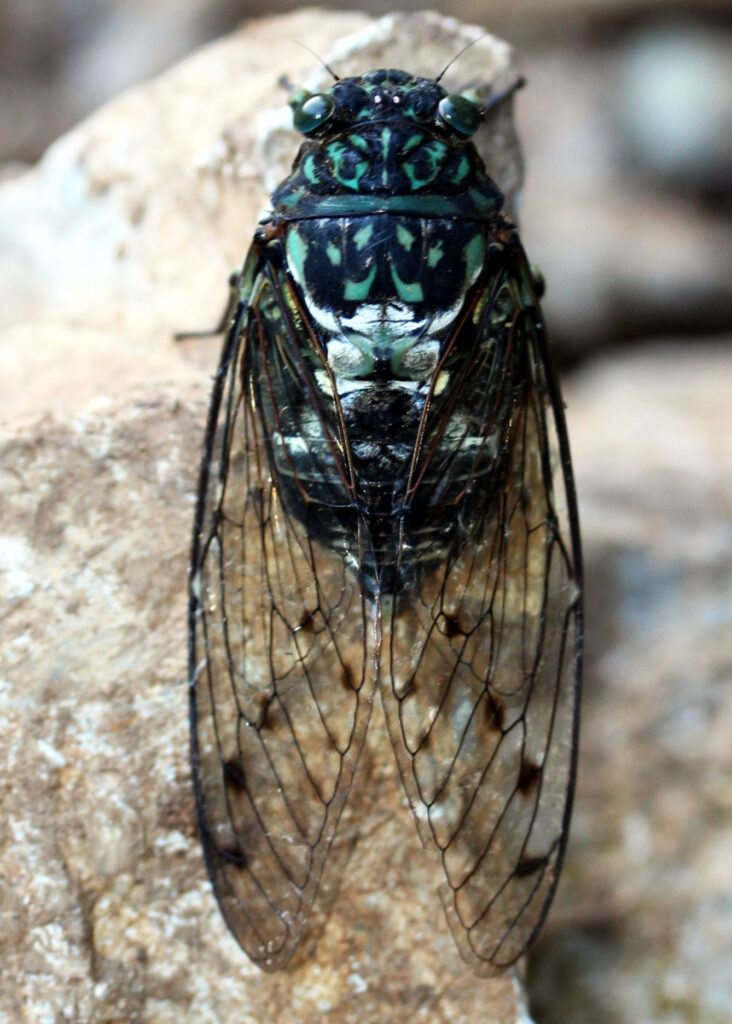
On a rainy evening, on my way back from the gym, I heard the cicadas chirping for the first time this year. The rainy season in Kansai is expected to end around the 20th, so it’s about a week earlier than usual for the first cicada cries. A cicada’s life is about seven years underground, with only about seven days spent above ground. The males chirp continuously for seven days in search of a female. It is said that less than 30% of male cicadas find a mate during this period. In summer, we often see dead male cicadas lying on their backs in the middle of the road, but more than 70% of them die without ever finding a mate.
From the sound, I could tell that the first cicada I heard was a Minmin-zemi. Since 2021, NHK has been conducting a “Cicada Survey.” According to the submissions from all over the country, the Aburazemi dominates in urban areas, but Minmin-zemi and Higurashi, which have mostly been seen in mountainous areas in Kansai, have been confirmed in urban parks in Osaka. Additionally, Kumazemi, which was previously considered to have its northern limit in western Kanagawa Prefecture, has been confirmed over a wide area of the Kanto region, revealing changes in their habitat range.
By the way, have you heard of the “Prime Number Cicadas”? In Illinois, USA, there are cicadas that appear in large numbers every 13 years and others that appear every 17 years. Since 13 and 17 are prime numbers, they are called prime number cicadas. This year, 2024, is a year when these cycles overlap, prompting warnings. The residents of Illinois will witness an astonishing number of cicadas swarming the trees, mating, and dying. However, for the people of Illinois, this is a fleeting spectacle. After filling the air with their deafening noise, the cicadas will disappear. For many other living creatures, plants, and microorganisms in the central US, these cicadas are a rare feast and, even in death, contribute to the forest’s renewal.
This phenomenon occurs every 221 years, making 2024 a fortunate year for the people of Illinois. Incidentally, the mystery of these 13-year and 17-year cicadas was solved by Japanese researchers.
雨上がりの夕方、ジムからの帰り道で今年初めてセミの鳴き声を聞きました。今年の梅雨明けは、関西では20日頃と予想されていますから、1週間くらい早い初鳴きです。セミの一生は、7年間地中で暮らし、地上で暮らすのは7日間くらいだそうです。鳴いているのは雄ゼミで、雌ゼミを求めて7日間鳴き続けるわけです。その間雌ゼミ出会える雄ゼミは30%未満だといわれています。夏になると道の真ん中で仰向けになった雄ゼミの死体をよく見かけますが、その70%以上は雌に出会うことなく大往生した雄ゼミです。
初セミは鳴き声から判断してミンミンゼミです。NHKが2021年から「セミ大調査」をしていて、全国から寄せられた投稿によって、都市部ではアブラゼミが圧倒的な存在をみせていますが、関西地方ではおもに山地でみられてきたミンミンゼミやヒグラシが大阪の都市部の公園でも確認され、神奈川県西部を北限とされてきたクマゼミが関東地方の広い範囲で確認されるなど、生息範囲に変化が起きていることが明らかになりました。
ところで皆さん、「素数ゼミ」というセミをご存じでしょうか。アメリカのイリノイ州では、13年ごとに大量発生するセミと17年ごとに大量発生するセミがいて、13と17が素数ですので素数ゼミと呼ばれているのですが、今年2024年がその周期がぶつかり合う年で、警戒を呼び掛けているのです。イリノイ州の住人たちは、身近にある木の上ですさまじい数のセミがうごめき、愛を交わし、死んでいく光景を目撃することになるはずです。しかし、イリノイ州の人たちにとって、それはつかの間の光景で、耳をつんざく騒音をまき散らした末に、セミたちは姿を消します。そして、米中西部に生息するほかの多くの生き物や植物、微生物にとって、それはめったに味わえないごちそうであり、死してなお長きにわたり森林に新たな命をもたらしてくれる存在なのです。
これは221年ごとに起こる出来事で、イリノイ州の人たちにとって2024年はラッキーな年ともいえるわけです。ちなみに、この13年ゼミと17ゼミの謎は日本の研究者が解き明かしています。
